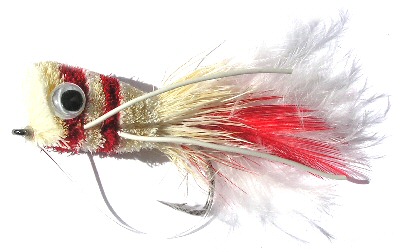Red and White Popper Bass Bug
Deer hair bass bug fly fishing patterns perform like a hard headed wooden poppers but they are very light. They have the advantage when you need to cast a fly to a nearby largemouth or black bass without spooking it.

DEERHAIR BASS BUG FLY PATTERNS. Hook size 6 - $US each
The red and white surface popper bass bug regularly catches big fish like the Black Bass. Described as big-headed, pot-bellied and by some as the lip that swims, the American black bass gets poor press for its looks. These descriptions could equally apply to its running water cousins the largemouth bass and the smallmouth bass. They are native to many States in the east of America though they have been introduced to lakes in the west and farmed. It can be found in all 48 lower States. It may not look as slim line and pretty as other fish but it makes up for these shortfalls in fighting power. It has been described in the fly fishing press as the hardest-fighting freshwater fish in North America. If you get one on your line and see it scream off the line on your reel and then jump up in the air shaking its head in an effort to dislodge your hook again and again, you will agree with the claim. A good fish ranges from 1lb to 8lb though there have been some monsters caught that were over 20lb.
The Black Bass prefers still or slow moving water and thrives in rural areas although it can be found in some surprising urban environments. It is essentially a warm water fish and grows fastest in the deep south especially Florida. Fly fishing success for Black Bass and largemouth bass requires an understanding of the ambush tactics that these fish use to catch their prey. These are not fish that spend their day actively hunting and swimming after their food. They like to preserve their energy and lie in wait, well hidden. They use aquatic structure, any kind of underwater obstacle, which can provide cover, to try and become invisible. Tree roots, fallen timber, large clumps of vegetation, rock ledges and drop-offs are ideal
Once you have detected this type of underwater structure you now have to work out how to get your artificial fly to pass this location. Trying to entice Black bass out of their lairs may mean fishing not only close to snags, but right among them. Competition bass anglers do not hesitate to put a fly into impossible looking locations. This is how they win by using their accurate casting. This skill is one you need to perfect if you want to increase the amount of black bass and largemouths you catch. If you do not live near a lake or river go the local park and practice casting to targets placed at different distances from where you are standing. Yes you will get some strange looks but do not pay them any attention. Accurate casting needs lots of practice.
A lot of the time your fly will have to pass over and through weedbeds, rushes, reeds, grasses, brushwood and timber. All designed to snag a fishing hook tip. This is why all our deerhair bass bugs have a nylon weed guard incorporated in their design. They are strong enough to deflect most snags but give way to the powerful jaws of a black bass.
During the early season pre-spawning period, black bass move into marginal shallows and take up positions amongst the vegetation. In clear water they can see bright coloured bass bugs from a good distance, and fishing amongst the snags may not be necessary. Most good bass waters are coloured and it pays to get your artificial fly in as close as you can to the fish.


Bass Bug books

